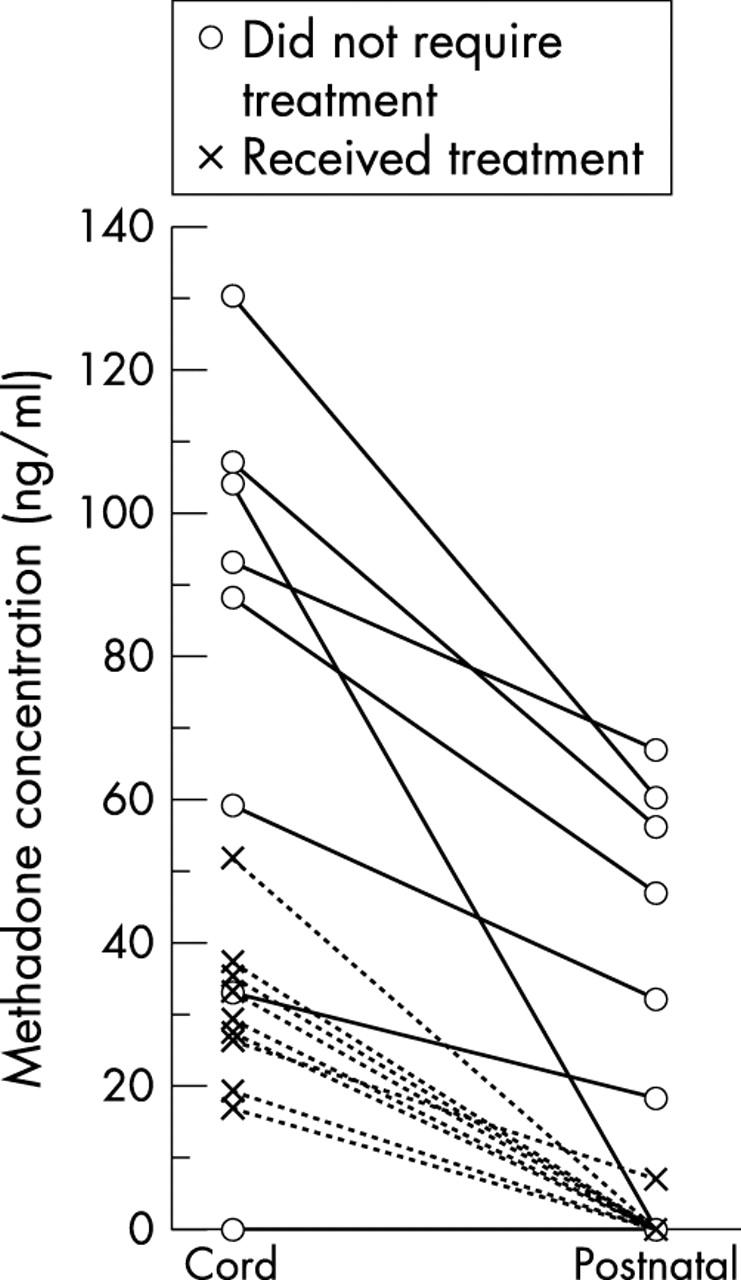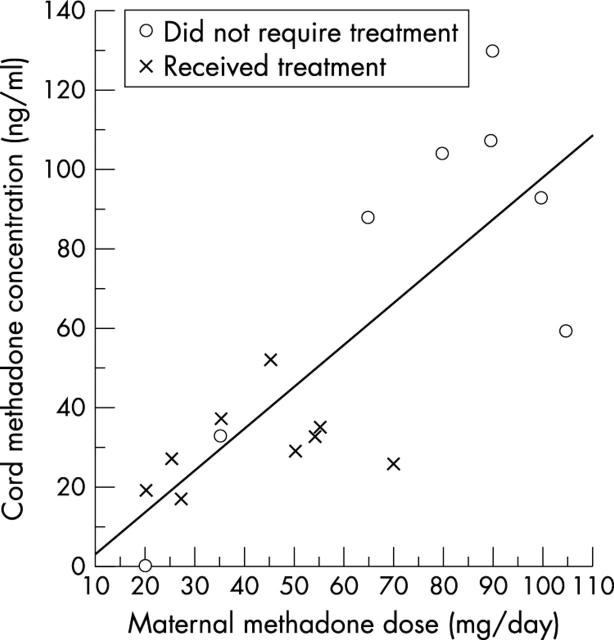Abstract
Aim: To assess the usefulness of cord and serum methadone concentrations at 2 days of age in predicting the severity of neonatal abstinence syndrome (NAS) in infants whose mothers received methadone during pregnancy.
Methods: After informed consent, infants were enrolled if they were delivered at 35 weeks gestation or greater. Relevant information was collected from maternal notes. A sample of cord blood was taken at delivery, with a follow up sample at 48 hours of age. The samples were analysed in batches, and the results were unavailable to the attending clinical staff. Infants were treated for NAS on clinical grounds according to a standardised scoring system.
Results: Twenty five of 36 eligible infants over the 21 month period of the study were enrolled. Of these, 12 required treatment for NAS. Maternal methadone dose did not predict the need for treatment. However, infants who required treatment had significantly lower methadone concentrations in cord blood than the group who did not receive treatment (31 v 88 ng/ml respectively; p = 0.029). Paired blood samples for methadone concentrations were available for 17 infants. All but one of the 12 infants who required treatment had undetectable concentrations of methadone in the postnatal sample, whereas the median postnatal methadone concentration in untreated infants was 23 ng/ml (p = 0.002).
Conclusions: Methadone concentrations taken from cord blood may identify infants at greater risk of neonatal withdrawal and therefore requiring treatment.
Full Text
The Full Text of this article is available as a PDF (85.9 KB).
Figure 1.
Relation between maternal methadone dose and cord methadone concentration. R2 = 0.59, p < 0.0001.
Figure 2.

Cord and postnatal (48 hour) methadone concentrations.
Selected References
These references are in PubMed. This may not be the complete list of references from this article.
- Bar-Oz B., Klein J., Karaskov T., Koren G. Comparison of meconium and neonatal hair analysis for detection of gestational exposure to drugs of abuse. Arch Dis Child Fetal Neonatal Ed. 2003 Mar;88(2):F98–F100. doi: 10.1136/fn.88.2.F98. [DOI] [PMC free article] [PubMed] [Google Scholar]
- Begg E. J., Malpas T. J., Hackett L. P., Ilett K. F. Distribution of R- and S-methadone into human milk during multiple, medium to high oral dosing. Br J Clin Pharmacol. 2001 Dec;52(6):681–685. doi: 10.1046/j.1365-2125.2001.01506.x. [DOI] [PMC free article] [PubMed] [Google Scholar]
- Dashe Jodi S., Sheffield Jeanne S., Olscher Debora A., Todd Sally J., Jackson Gregory L., Wendel George D. Relationship between maternal methadone dosage and neonatal withdrawal. Obstet Gynecol. 2002 Dec;100(6):1244–1249. doi: 10.1016/s0029-7844(02)02387-6. [DOI] [PubMed] [Google Scholar]
- Doberczak T. M., Kandall S. R., Friedmann P. Relationship between maternal methadone dosage, maternal-neonatal methadone levels, and neonatal withdrawal. Obstet Gynecol. 1993 Jun;81(6):936–940. [PubMed] [Google Scholar]
- Doberczak T. M., Kandall S. R., Wilets I. Neonatal opiate abstinence syndrome in term and preterm infants. J Pediatr. 1991 Jun;118(6):933–937. doi: 10.1016/s0022-3476(05)82214-0. [DOI] [PubMed] [Google Scholar]
- Harper R. G., Solish G., Feingold E., Gersten-Woolf N. B., Sokal M. M. Maternal ingested methadone, body fluid methadone, and the neonatal withdrawal syndrome. Am J Obstet Gynecol. 1977 Oct 15;129(4):417–424. doi: 10.1016/0002-9378(77)90588-9. [DOI] [PubMed] [Google Scholar]
- Kandall S. R., Albin S., Gartner L. M., Lee K. S., Eidelman A., Lowinson J. The narcotic-dependent mother: fetal and neonatal consequences. Early Hum Dev. 1977 Oct;1(2):159–169. doi: 10.1016/0378-3782(77)90017-2. [DOI] [PubMed] [Google Scholar]
- Kandall S. R., Doberczak T. M., Mauer K. R., Strashun R. H., Korts D. C. Opiate v CNS depressant therapy in neonatal drug abstinence syndrome. Am J Dis Child. 1983 Apr;137(4):378–382. doi: 10.1001/archpedi.1983.02140300056015. [DOI] [PubMed] [Google Scholar]
- Mack G., Thomas D., Giles W., Buchanan N. Methadone levels and neonatal withdrawal. J Paediatr Child Health. 1991 Apr;27(2):96–100. doi: 10.1111/j.1440-1754.1991.tb00360.x. [DOI] [PubMed] [Google Scholar]
- Malpas T. J., Darlow B. A. Neonatal abstinence syndrome following abrupt cessation of breastfeeding. N Z Med J. 1999 Jan 22;112(1080):12–13. [PubMed] [Google Scholar]
- Ostrea E. M., Jr, Chavez C. J., Strauss M. E. A study of factors that influence the severity of neonatal narcotic withdrawal. Addict Dis. 1975;2(1-2):187–199. [PubMed] [Google Scholar]
- Ostrea E. M., Jr, Knapp D. K., Tannenbaum L., Ostrea A. R., Romero A., Salari V., Ager J. Estimates of illicit drug use during pregnancy by maternal interview, hair analysis, and meconium analysis. J Pediatr. 2001 Mar;138(3):344–348. doi: 10.1067/mpd.2001.111429. [DOI] [PubMed] [Google Scholar]
- Rahbar F. Observations on methadone withdrawal in 16 neonates. Clin Pediatr (Phila) 1975 Apr;14(4):369–371. doi: 10.1177/000992287501400408. [DOI] [PubMed] [Google Scholar]
- Rosen T. S., Pippenger C. E. Pharmacologic observations on the neonatal withdrawal syndrome. J Pediatr. 1976 Jun;88(6):1044–1048. doi: 10.1016/s0022-3476(76)81074-8. [DOI] [PubMed] [Google Scholar]
- Strauss M. E., Andresko M., Stryker J. C., Wardell J. N., Dunkel L. D. Methadone maintenance during pregnancy: pregnancy, birth, and neonate characteristics. Am J Obstet Gynecol. 1974 Dec 1;120(7):895–900. doi: 10.1016/0002-9378(74)90335-4. [DOI] [PubMed] [Google Scholar]
- Strauss M. E., Andresko M., Stryker J. C., Wardell J. N. Relationship of neonatal withdrawal to maternal methadone dose. Am J Drug Alcohol Abuse. 1976;3(2):339–345. doi: 10.3109/00952997609077202. [DOI] [PubMed] [Google Scholar]
- Wilson G. S., Desmond M. M., Wait R. B. Follow-up of methadone-treated and untreated narcotic-dependent women and their infants: health, developmental, and social implications. J Pediatr. 1981 May;98(5):716–722. doi: 10.1016/s0022-3476(81)80830-x. [DOI] [PubMed] [Google Scholar]
- Zelson C., Lee S. J., Casalino M. Neonatal narcotic addiction. Comparative effects of maternal intake of heroin and methadone. N Engl J Med. 1973 Dec 6;289(23):1216–1220. doi: 10.1056/NEJM197312062892303. [DOI] [PubMed] [Google Scholar]
- van Baar A. L., Fleury P., Soepatmi S., Ultee C. A., Wesselman P. J. Neonatal behavior after drug dependent pregnancy. Arch Dis Child. 1989 Feb;64(2):235–240. doi: 10.1136/adc.64.2.235. [DOI] [PMC free article] [PubMed] [Google Scholar]



